AUDI TT COUPE 2017 Owners Manual
Manufacturer: AUDI, Model Year: 2017, Model line: TT COUPE, Model: AUDI TT COUPE 2017Pages: 322, PDF Size: 79.73 MB
Page 231 of 322
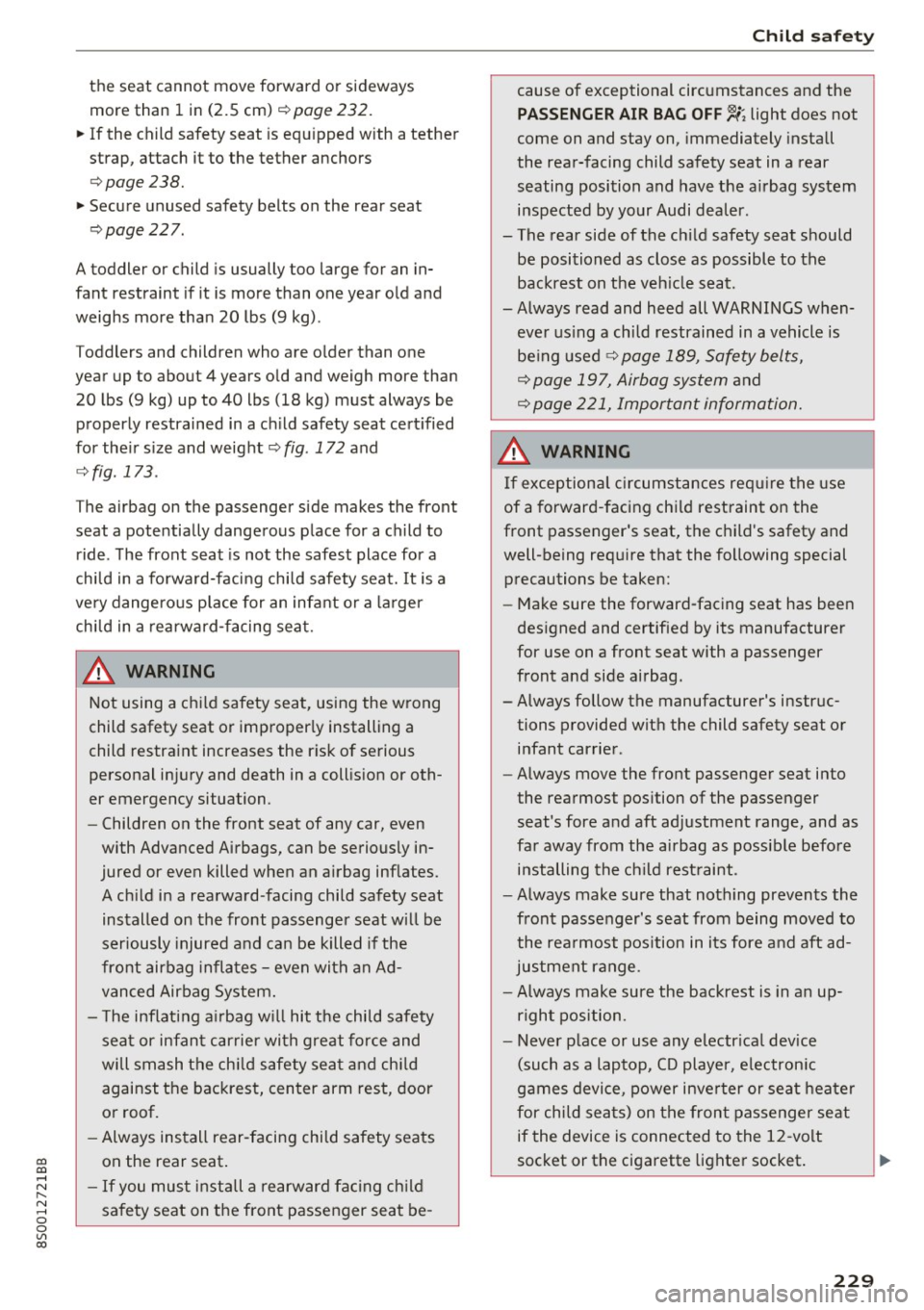
co
co
.... N
" N .... 0
0
Vl c:o
the seat cannot move forward or sideways more than 1 in (2.5 cm)
¢ page 232.
~ If the child safety seat is equ ipped with a tether
strap, attach it to the tether anchors
¢ page 238.
~ Secure unused safety belts on the rear seat
¢page 227 .
A toddler or child is usually too large for an in
fant restraint if it is more than one year old and
weighs more than 20 lbs (9 kg) .
T oddlers and children who are o lder than one
year up to about 4 years old and weigh more than 20 lbs (9 kg) up to 40 lbs (18 kg) must always be
properly restrained in a ch ild safety seat cert ified
for the ir s ize and weight ¢
fig. 172 and
¢ fig. 173 .
The airbag on the passenger side makes the front
seat a potentially dangerous place for a child to
ride . The front seat is not the safest place for a
chi ld in a fo rward-facing chi ld safety seat. It is a
ve ry dangero us p lace for an infant or a la rger
ch ild in a rearward -facing seat.
_.6 WARNING
-Not using a ch ild safety seat, using the wrong
child safety seat or improper ly installing a
child restraint increases the risk of serious
personal injury and death in a collis ion or oth
er emergency situation.
- Children on the front seat of any car, even
with Advanced Airbags, can be seriously in
jured or even killed when an a irbag inflates.
A ch ild in a rearward-facing child safety seat
installed on the front passenger seat will be
seriously injured and can be killed if the
front airbag inflates - even with an Ad
vanced Airbag System.
- T he inflating a irbag w ill hit the child safety
seat or infant carrier with great force and
will smash the ch ild safety seat and chi ld
against the backrest, center arm rest, door
or roof.
- Always install rear-facing child safety seats
on the rear seat.
- If you must install a rearward facing ch ild
safety seat on the front passenger seat be -
Child safety
cause of exceptional circumstances and the
PASS ENGER AIR BAG OFF~; light does not
come on and stay on, immediately install
the rear-facing child safety seat in a rear
seating position and have the a irbag system
inspected by your Audi dealer.
- The rear side of the ch ild safety seat should
be positioned as close as possible to the
backrest on the veh icle seat.
-Always read and heed all WARNINGS when eve r us ing a child restrained in a vehicle is
be ing used <>
page 189, Safety belts,
<> page 197, Airbag sys tem and
<> page 221, Important information.
_& WARNING
If exceptional c ircumstances req uire the use
of a forward -facing chi ld restraint on the
front passenger's seat, the child's safety and
well-being req uire that the following special
precautions be taken:
- Make sure the forward-fac ing seat has been
des igned and certified by its manufacturer
for use on a front seat with a passenger
front and side airbag.
-Always follow the manufacturer's instruc tions provided with the child safety seat or infant carrier .
- Always move the front passenger seat into
the rearmost pos ition of the passenger
seat's fore and aft adjustment range, and as
far away from the airbag as possible before installing the ch ild rest raint .
- Always make sure that nothing prevents the
front passenger's seat from being moved to
the rea rmost pos ition in its fore and aft ad
justment range.
- Always make sure the backrest is in an up
right position.
- Never p lace or use any electr ica l device
(such as a laptop, CD player, e lectron ic
games device, power inve rter or sea t hea ter
for child seats) on the front passenger seat
if the device is connected to the 12-volt
socket or the cigarette lighter socket. .,,.
229
Page 232 of 322
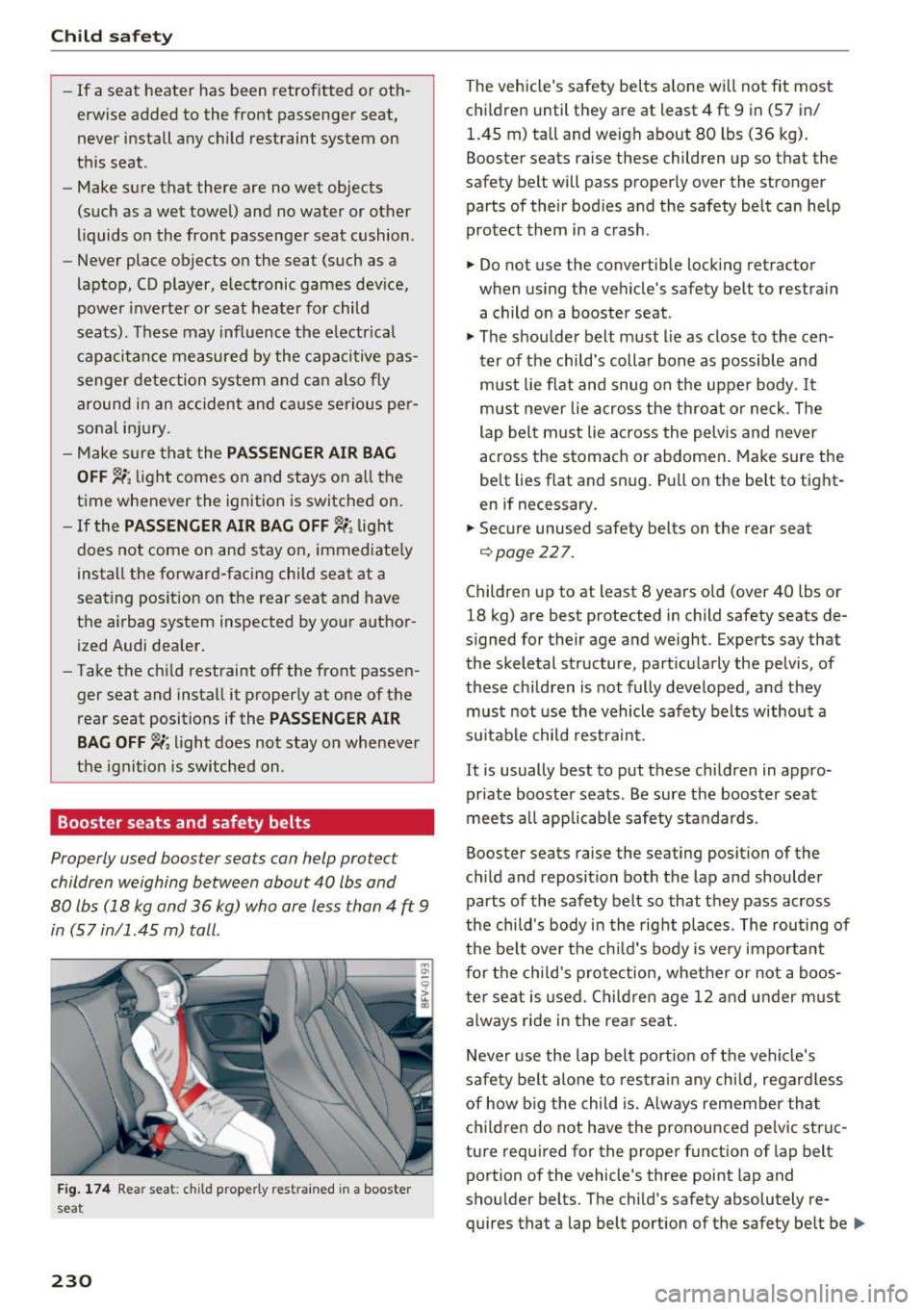
Child safety
-If a seat heater has been retrof itted or oth
erwise added to the front passenger seat,
never install any child restraint system on
this seat .
- Make sure that there are no wet objects
(such as a wet towe l) and no water or other
liquids on the front passenger seat cushion .
- Never place objects on the seat (such as a
laptop, CD player, electronic games device,
power inverter or seat heater for child
seats) . These may influence the e lectr ica l
capacitan ce measured by the capacitive pas
senger detection system and can also fly
around in an acc ident and ca use serio us pe r
sonal injury .
- Make s ure tha t the
PASSENGER AIR BAG
OFF ~;
light comes on and stays on a ll the
time whenever the ignition is switched on.
- If the PASSENGER AIR BAG OFF 1i; light
does not come on and stay on, immediate ly
insta ll the forward-facing child seat at a
seating position on the rear seat and have
the a irbag system inspected by your author
ized Audi dealer.
- Take the ch ild restraint off the front passen
ger seat and install it properly at one of the
rear seat positions if the
PASSEN GER AIR
BAG OFF ~;
light does not stay on whenever
the ignition is switched on .
Booster seats and safety belts
Properly used booster sea ts can help protect
children weighing between about 40 lbs and
80 lbs (18 kg and 36 kg) who are less than 4 ft 9
in (57 in/1 .45 m) tall.
F ig . 17 4 Rea r seat: chi ld p roper ly restra ined in a booster
seat
230
The vehicle's safety belts alone wi ll not fit most
children until they are at least 4
ft 9 in (57 in/
1.45 m) tall and weigh about 80 lbs (36 kg) .
Booster seats raise these children up so that the
safety be lt will pass properly over the stronger
parts of their bodies and the safety belt can help
protect them in a crash.
.. Do not use the convertib le locking retractor
when us ing the ve hicle's safety belt to restra in
a child on a booster seat .
.., The shoulder belt must lie as close to the cen
ter of the child's collar bon e as possib le and
must l ie flat and snug on the uppe r body.
It
must never lie across the throat or neck. The
lap belt must lie ac ross the pelvis and never
across t he stomach or abdomen . Make sure the
belt lies flat and snug. Pu ll on the belt to tight
en if necessary.
.. Secure unused safety belts on the rear seat
¢page 227.
Children up to at least 8 years o ld (over 40 lbs or
18 kg) are best protected in child safety seats de
s igned for their age and weight. Experts say that
the skeletal structure, part icu larly the pelvis, of
these children is not fully developed, and they must not use the vehicle safety belts without a
su itab le child restra int.
It is usually best to put these children in appro
pr iate booster seats . Be sure the booster seat
meets a ll applicab le safety standards .
Booster seats raise the seating position of the
c hi ld and reposition both the lap and shoulder
parts of the safety belt so that they pass across
the chi ld's body in the right places . The rou ting of
the be lt over the ch ild's body is very important
fo r the child's protection, whet he r or not a boos
ter seat is used. C hildren age 12 and under m ust
a lways ride in the rear seat.
Never use the lap belt port ion of the vehicle's
safety belt alone to restra in any child, regard less
of how b ig the child is. A lways remember that
c hi ldre n do not have the pronounced pe lvic struc
ture requ ired for the proper function of lap belt
portion of the vehicle 's three point lap and
shou lder belts. The chi ld's safety absolutely re
quires that a lap belt port ion of the safety belt be ...,
Page 233 of 322
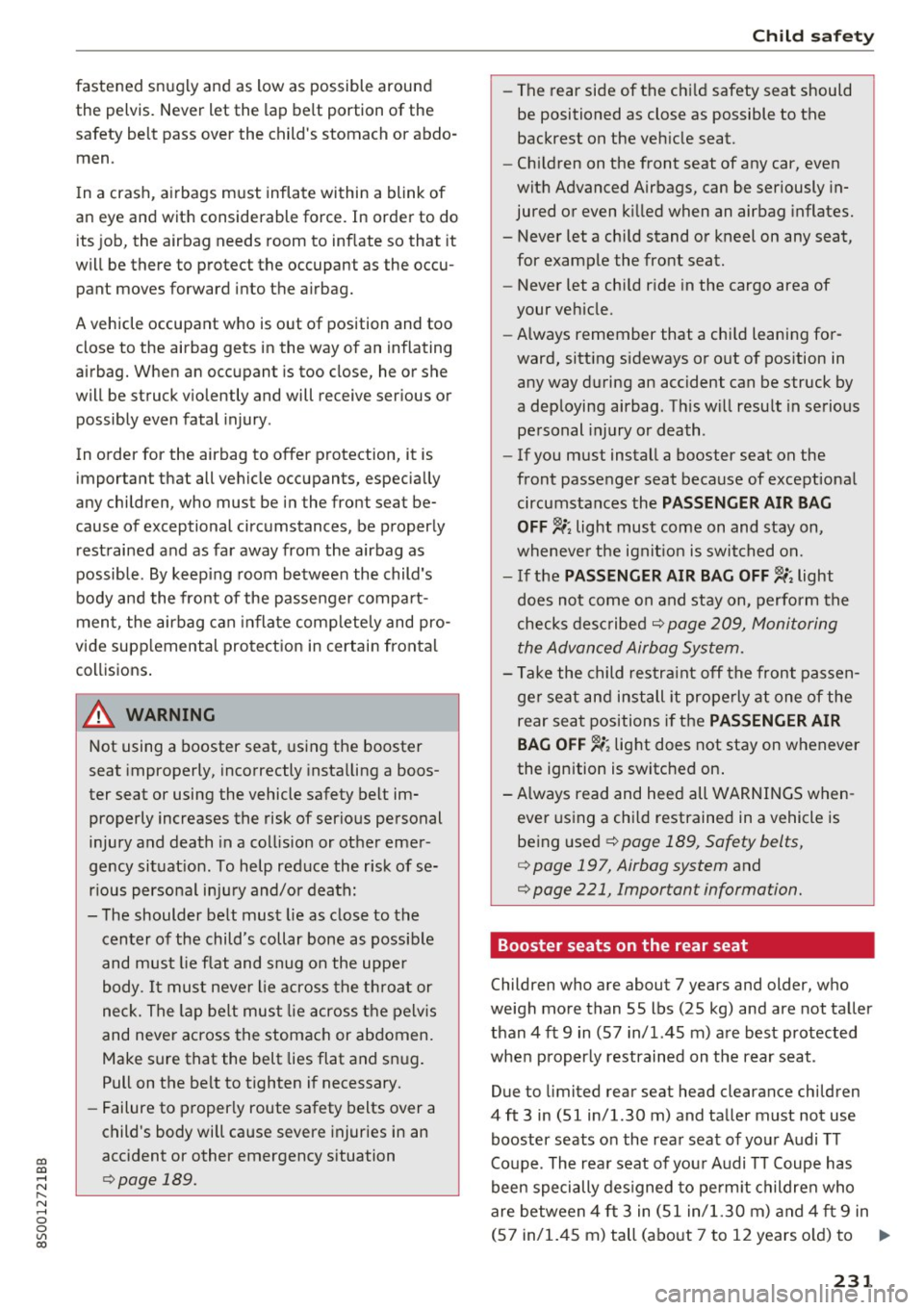
co
co
.... N
" N .... 0
0
Vl c:o
fastened snugly and as low as possible around
the pelvis. Never let the lap belt portion of the
safety belt pass over the child's stomach or abdo
men .
I n a crash, a irbags must inflate within a blink of
an eye and with considerable force. In order to do its job, the airbag needs room to inflate so that it
will be there to protect the occupant as the occu
pant moves forward into the a irbag.
A vehicle occupant who is out of position and too
close to the airbag gets in the way of an inflating
airbag. When an occupant is too close, he or she
will be struck v iolently and will receive ser ious or
possibly even fatal injury .
In order for the airbag to offer protection, it is important that all vehicle occupants, especially
any children, who must be in the front seat be
cause of exceptional circumstances, be properly restrained and as far away from the airbag as
possible . By keep ing room between the child's
body and the front of the passenger compart
ment, the airbag can inflate comp letely and pro
vide supp lemental prote ct ion in certain frontal
collisions .
A WARNING
Not using a booster seat, us ing the booster
seat improperly, incorrectly insta lling a boos
ter seat or using the vehicle safety belt im properly increases the risk of serious personal
injury and death in a collision or other emer
gency situat ion. To help reduce the risk of se
r ious personal inju ry and/or death:
- The shoulder belt must lie as close to the
center of the child 's collar bone as possible
and must lie flat and snug on the uppe r
body .
It must neve r lie across the th roat or
neck. The lap belt must lie across the pelv is
and never across the stomach or abdomen.
Make sure that the belt lies flat and snug .
Pull on the belt to tighten if necessary.
- Failure to proper ly route safety belts over a
child's body will cause severe injuries in an
acc ident or other emergency situation
9 page 189 .
Ch ild safety
- The rear side of the ch ild safety seat should
be positioned as close as possible to the
backrest on the veh icle seat.
- Ch ildren on the front seat of any car, even
with Advanced Airbags, can be seriously in
jured or even k illed when an airbag inflates.
- Never let a chi ld stand or kneel on any seat,
for example the front seat.
- Never let a chi ld r ide in the cargo area of
your veh icle.
- Always remember that a chi ld leaning for
ward, sitt ing sideways or o ut of pos ition in
any way du ring an accident can be struck by
a dep loying airbag. Th is w ill resu lt in serious
pe rsonal injury or death.
- If you must install a booster seat on the
front passenger seat because of exceptiona l
circumstances the
PASSENGER AIR BAG
OFF ~;
light must come on and stay on,
wheneve r the ignit ion is swit ched on.
- If the PASSENGER AIR BAG OFF~; light
does not come on and stay on, perform the
checks desc ribed
9 page 209, Monitoring
the Advanced Airbag System.
- T ake the child restra int off the front passen
ge r seat and install it prope rly a t one of the
rear sea t positions i f the
PASSENGER AIR
BAG OFF~;
light does not stay on whenever
the ignition is switched on .
- Always read and heed all WARNINGS when
ever using a child restrained in a vehicle is
being used
¢ page 189, Safety belts,
¢ page 197 , Airbag system and
¢ page 221, Important information.
Booster seats on the rear seat
Children who are about 7 years and older, who
weigh more than 55 lbs (25 kg) and are not tal ler
than 4 ft 9 in (57 in/1.45 m) are best protected
whe n properly restrained on t he rear seat.
Due to limited rear seat head clearance children
4
ft 3 in (51 in/1.30 m) and taller must not use
booster seats o n the rea r seat of your Audi TT
Co upe . The rea r seat of you r Audi TT Coupe has
been specially des igned to pe rm it children who
are between 4 ft 3 in (51 in/1.30 m) and 4
ft 9 in
(57 in/1.45 m) tall (abo ut 7 to 12 years o ld) to ..,.
231
Page 234 of 322
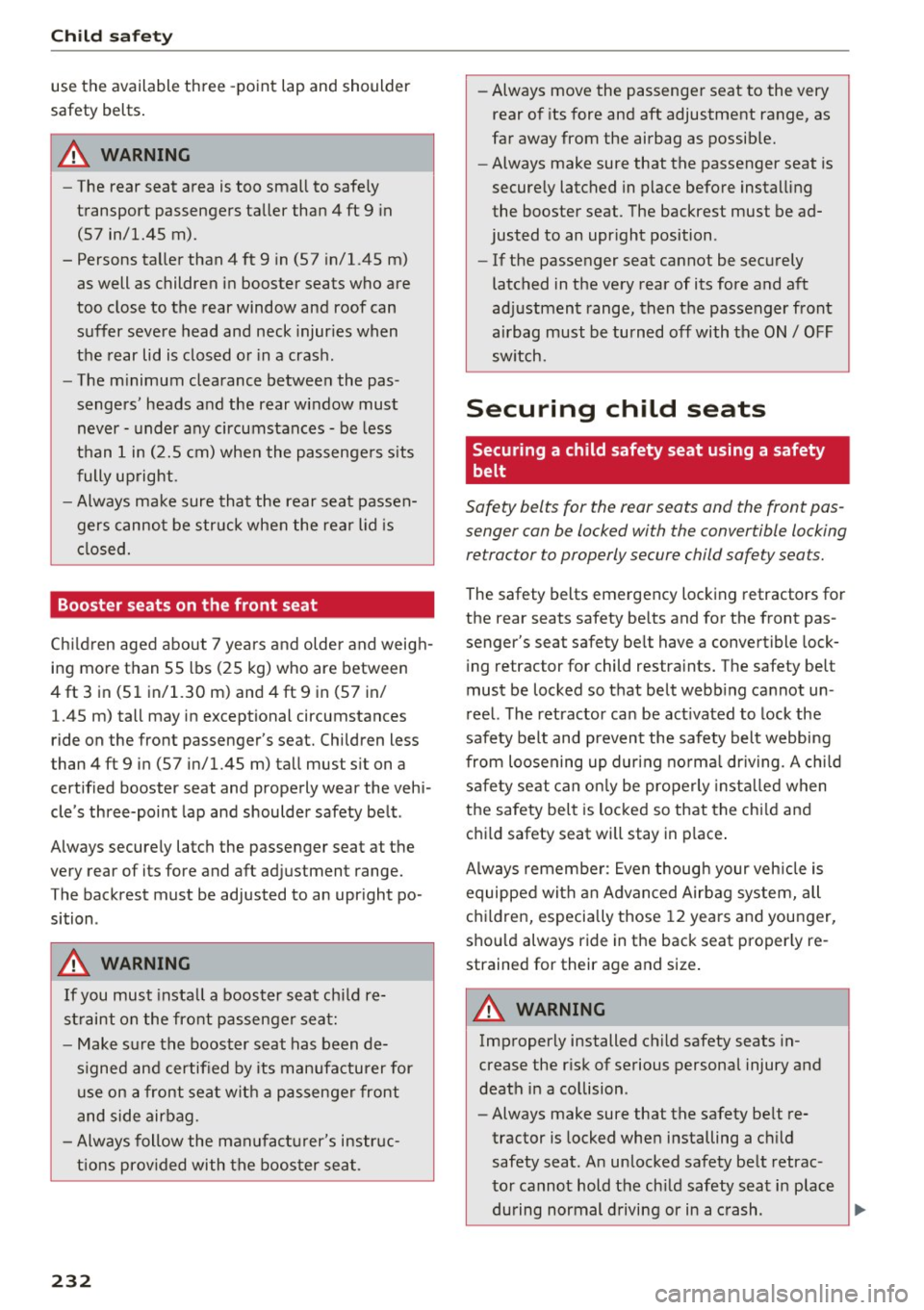
Child safet y
use the available th ree -point lap and shoulder
safety belts .
A WARNING
-The rear seat area is too small to safe ly
transport passengers taller than 4 ft 9 in
(57 in/1.45 m).
-
- Persons taller than 4 ft 9 in (57 in/1.45 m) as well as children in booster seats who are
too close to the rear window and roof can
suffer severe head and neck injur ies when
the rear lid is closed o r in a crash.
- The m inimum clearance betwee n the pas
sengers' heads and the rear window must
never - under any circumstances - be less
than 1 in ( 2.5 cm) whe n the passenge rs s its
f ully up right .
- Always make sure tha t the rear seat passen
gers canno t be str uck when the rear lid is
cl osed.
Booster seats on the front seat
Ch ild ren aged about 7 years and older and weigh
ing more than 55 lbs (25 kg) who are between
4 ft 3 in (5 1 in/1.30 m) and 4 ft 9 in (57 in/
1.45 m) tall may in exceptional circumstances
ride on the front passenger's seat. Children less
than 4 ft 9 in (57 in/1.45 m) tall must s it on a
certified booster seat and properly wear the vehi
cle 's three-poin t lap and shoulder safety be lt .
Always securely latch the passenger seat at t he
very rear of its fore and aft adjustment range.
The bac krest must be adjusted to an upr ight po
sition .
A WARNING
If you must insta ll a booster seat ch ild re
st raint o n the fro nt passenger sea t:
- Make s ure the booster seat has been de
s igned and certified by its manufa ctu rer for
use on a front seat wit h a pas senge r fr ont
and side air bag.
- Alw ays follow the m anuf act urer's instruc
ti on s prov ided with the boos ter sea t.
232
- Always move the passenger seat to the very
rear o f its fore and aft adjustment range, as
far away from the airbag as possib le.
- Always make sure that the passenger seat is
secure ly latched in place before instal ling
the booster seat. The backrest must be ad
justed to an upr ight position .
- If the passenger seat cannot be secu rely
latched in the very rear of its fore and aft
ad justment range , then t he passenger front
airbag must be turned off with the ON / OFF
s w itch.
Securing child seats
Securing a child safety seat using a safety
belt
Safety belts for the rear seats and the front pas
senger can be locked with the convertible locking
retractor to properly secure child safety seats.
The safety belts emergency lock ing retractors for
the rear seats safety be lts and for the front pas
senger's seat safety be lt have a convert ible lock
i ng retractor for child restra ints. The safety belt
must be locked so t hat be lt webb ing ca nnot un
r eel. The retractor ca n be act ivated to lock the
safe ty belt and prevent the safety belt webbing
from loosening up dur ing no rm al driv ing. A chi ld
s a fe ty se at can on ly be prope rly insta lled when
the safety be lt is locked so that the ch ild and
c hi ld safety seat will stay in place .
Always remembe r: E ven thoug h your veh icle is
equipped wi th an Advan ced Airba g system, all
c hi ldren, especially those 12 yea rs and younger,
shou ld always ride in the back seat proper ly re
strained for their age and size .
A WARNING
Improperly installed child safety seats in
crease the r isk of serious personal injury and
death in a co llision .
-
-Always make sure that the safety be lt re
tractor is locked when installing a c hild
safety seat. An unlocked safety be lt retrac
to r cannot hold the ch ild safety seat in place
during normal d riving or in a c rash.
Page 235 of 322
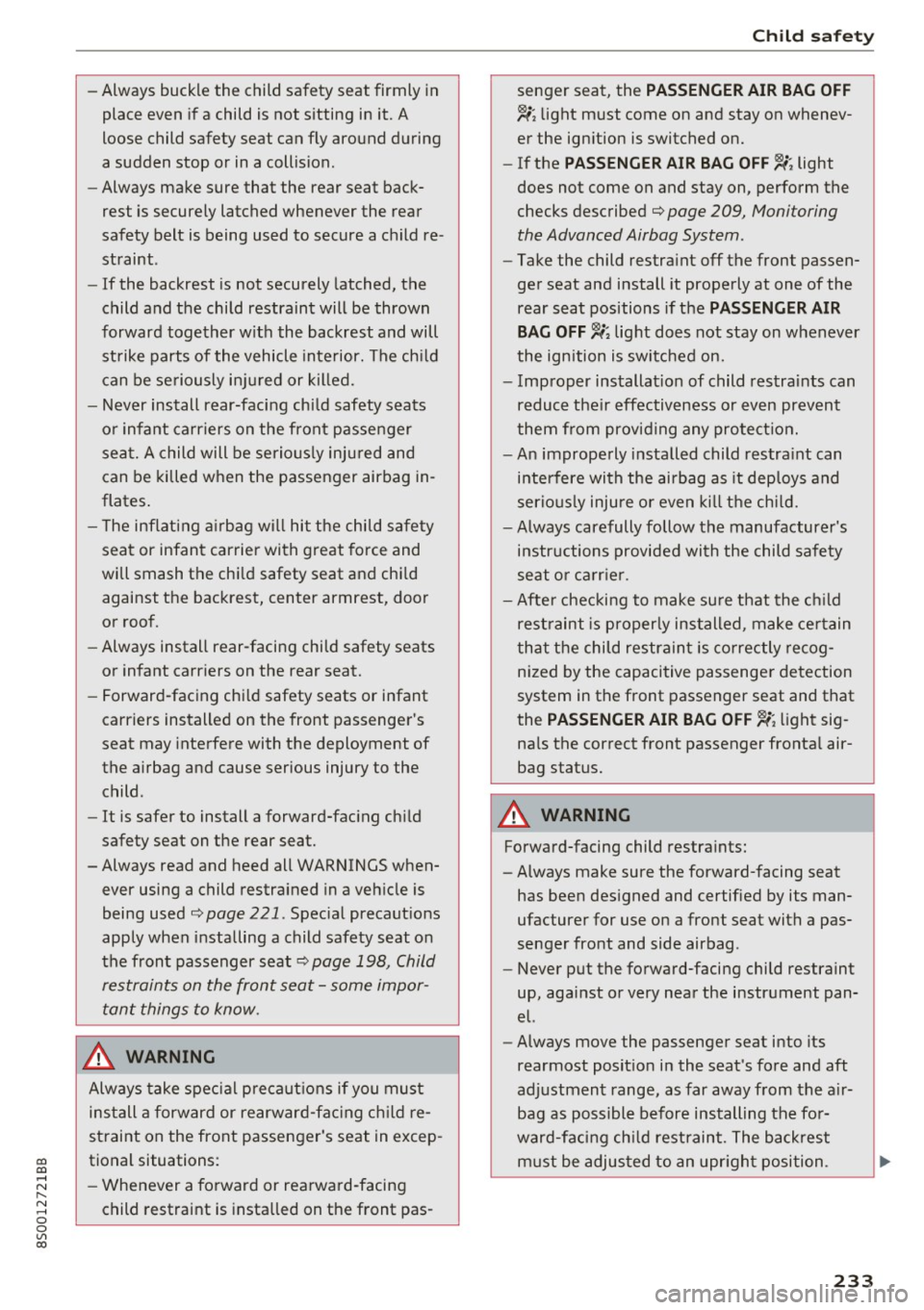
co
co
.... N
" N .... 0
0
Vl c:o
-Always buckle the child safety seat firmly in
place even if a child is not sitting in it. A
loose child safety seat can fly around during
a sudden stop or in a collision.
- Always make sure that the rear seat back
rest is securely latched whenever the rear
safety belt is being used to secure a child re
straint .
- If the backrest is not securely latched, the
child and the child restraint will be thrown
forward together w ith the backrest and will
st rike parts of the vehicle interior. The ch ild
can be se riously inj ured or killed.
- Never install rear-facing chi ld safety seats
o r infant carriers on the front passenger
seat. A child will be serious ly inju red and
can be killed when the passenger airbag in
flates .
- The inflating a irbag will hit the child safety
seat or infant carrier with great force and
will smash the chi ld safety seat and chi ld
against the backrest, center armrest, door
or roof.
- Always install rear-facing child s;:ifety seats
or infant carriers on the rear seat.
- Forward-facing ch ild safety seats or infant
carriers installed on the front passenger's
seat may interfere with the deployment of
the a irbag and cause serious injury to the
child .
- It is safer to install a forward-fac ing ch ild
safety seat on the rear seat.
-Always read and heed all WARNINGS when ever using a child restrained in a veh icle is
being used
¢ page 221. Spec ial precaut ions
apply when installing a child safety seat on
the front passenger seat
¢ page 198, Child
restraints on the front seat -some impor
tant things to know .
A WARNING
Always take spec ial precaut ions if you must
install a forward or rearward-fac ing ch ild re
straint on the front passenger 's seat in excep
tional situations:
- Whenever a forward or rea rward-facing
child restraint is installed on the front pas-
-
Ch ild safety
senger seat, the PASSENGER AIR BAG OFF
,r; light must come on and stay on whenev
er the ign ition is switched on.
- If the
PASS ENGER AIR BAG OF F ,r; light
does not come on and stay on, perform the
checks described
¢ page 209, Monitoring
the Advanced Airbag System .
-Take the child restra int off the front passen
ger seat and install it properly at one of the
rear seat positions if the
PA SSENGER AIR
BAG OFF
,r; light does not stay on whenever
the ignition is switched on.
- Improper installat ion of child restraints can
reduce the ir effectiveness or even prevent
them from providing any protect ion.
- An improperly installed child restra int can
interfere with the airbag as it deploys and
serio usly injure or even kil l the chi ld.
- Always carefully follow the manufacturer's
instr uctions provided wi th the child safety
seat o r ca rr ie r.
- After checking to make su re that the ch ild
rest raint is properly ins talled , make cer tain
that the child restrain t is correctly recog
n ized by the capacitive passenger detection
system in the front passenger seat and that
the
PASSENGER AIR BAG OFF ,r; li ght sig
na ls the correct front passenger fronta l air
bag status.
A WARNING
Forward-facing child restra ints:
- Always make sure the forward-facing seat
has been des igned and certified by its man
ufacturer for use on a front seat with a pas
senger front and side airbag .
- Never put the forward-facing child restraint
up, against or very near the instrument pan
el.
- Always move the passenger seat into its
rearmost posit ion in the seat's fore and aft
ad justment range, as far away from the a ir
bag as possible before installing the fo r
ward-facing ch ild restraint. The backrest
m ust be adjus ted to an upr igh t position .
233
Page 236 of 322
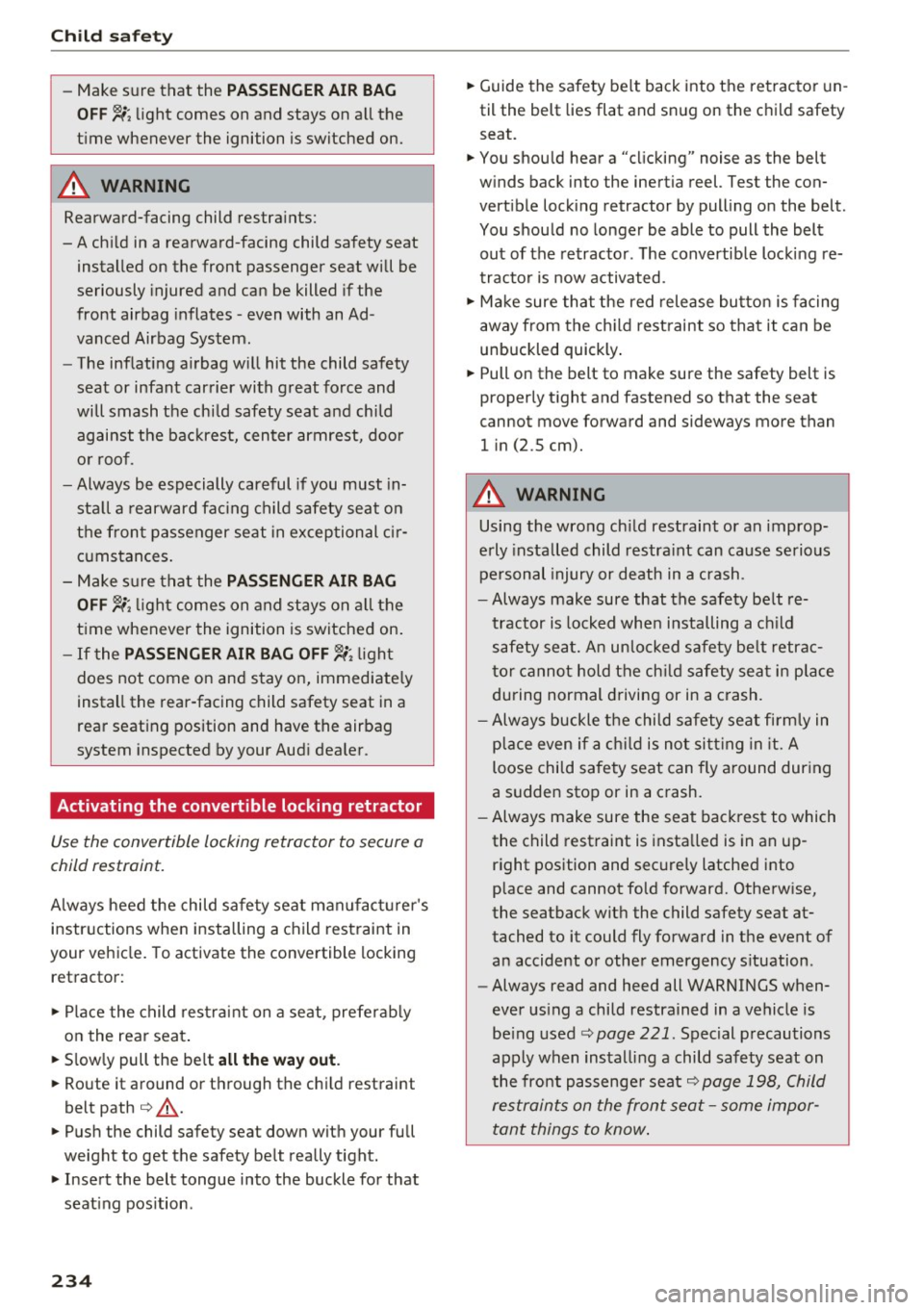
Child safety
-Make sure that the PASSENGER AIR BAG
OFF 11;; light comes on and stays on all the
time whenever the ignition is switched on.
_&. WARNING
Rearward-facing child restraints:
-A child in a rearward-facing child safety seat installed on the front passenger seat will be
seriously injured and can be killed if the
front airbag inflates - even with an Ad
vanced Airbag System.
- The inflating airbag will hit the child safety
seat or infant carrier with great force and
will smash the child safety seat and child
against the backrest, center armrest, door
or roof.
-Always be especially careful if you must in
stall a rearward facing child safety seat on
the front passenger seat in exceptional cir
cumstances.
- Make sure that the
PASSENGER AIR BAG
OFF 11;; light comes on and stays on all the
time whenever the ignition is switched on.
-If the PASSENGER AIR BAG OFF~; light
does not come on and stay on, immediately
install the rear-facing child safety seat in a
rear seating position and have the airbag
system inspected by your Audi dealer.
Activating the convertible locking retractor
Use the convertible locking retractor to secure a
child restraint.
Always heed the child safety seat manufacturer's
instructions when installing a child restraint in
your vehicle. To activate the convertible locking
retractor:
.,. Place the child restraint on a seat, preferably
on the rear seat.
.,. Slowly pull the belt
all the way out.
.,. Route it around or through the child restraint
belt path
¢ _A .
.,. Push the child safety seat down with your full
weight to get the safety belt really tight .
.,. Insert the belt tongue into the buckle for that
seating position .
234
.,. Guide the safety belt back into the retractor un
til the belt lies flat and snug on the child safety
seat.
.,. You should hear a "clicking" noise as the belt
winds back into the inertia reel. Test the con
vertible locking retractor by pulling on the belt .
You should no longer be able to pull the belt
out of the retractor. The convertible locking re
tractor is now activated.
.,. Make sure that the red release button is facing
away from the child restraint so that it can be
unbuckled quickly.
.,. Pull on the belt to make sure the safety belt is
properly tight and fastened so that the seat
cannot move forward and sideways more than
1 in (2.5 cm).
_&. WARNING
Using the wrong child restraint or an improp
erly installed child restraint can cause serious
personal injury or death in a crash.
- Always make sure that the safety belt re
tractor is locked when installing a child
safety seat. An unlocked safety belt retrac
tor cannot hold the child safety seat in place
during normal driving or in a crash.
-Always buckle the child safety seat firmly in
place even if a child is not sitting in it. A
loose child safety seat can fly around during
a sudden stop or in a crash.
- Always make sure the seat backrest to which
the child restraint is installed is in an up
right position and securely latched into
place and cannot fold forward. Otherwise,
the seatback with the child safety seat at
tached to it could fly forward in the event of
an accident or other emergency situation .
- Always read and heed all WARNINGS when
ever using a child restrained in a vehicle is
being used
¢ page 221. Special precautions
apply when installing a child safety seat on
the front passenger seat
¢ page 198, Child
restraints on the front seat -some impor
tant things to know.
Page 237 of 322
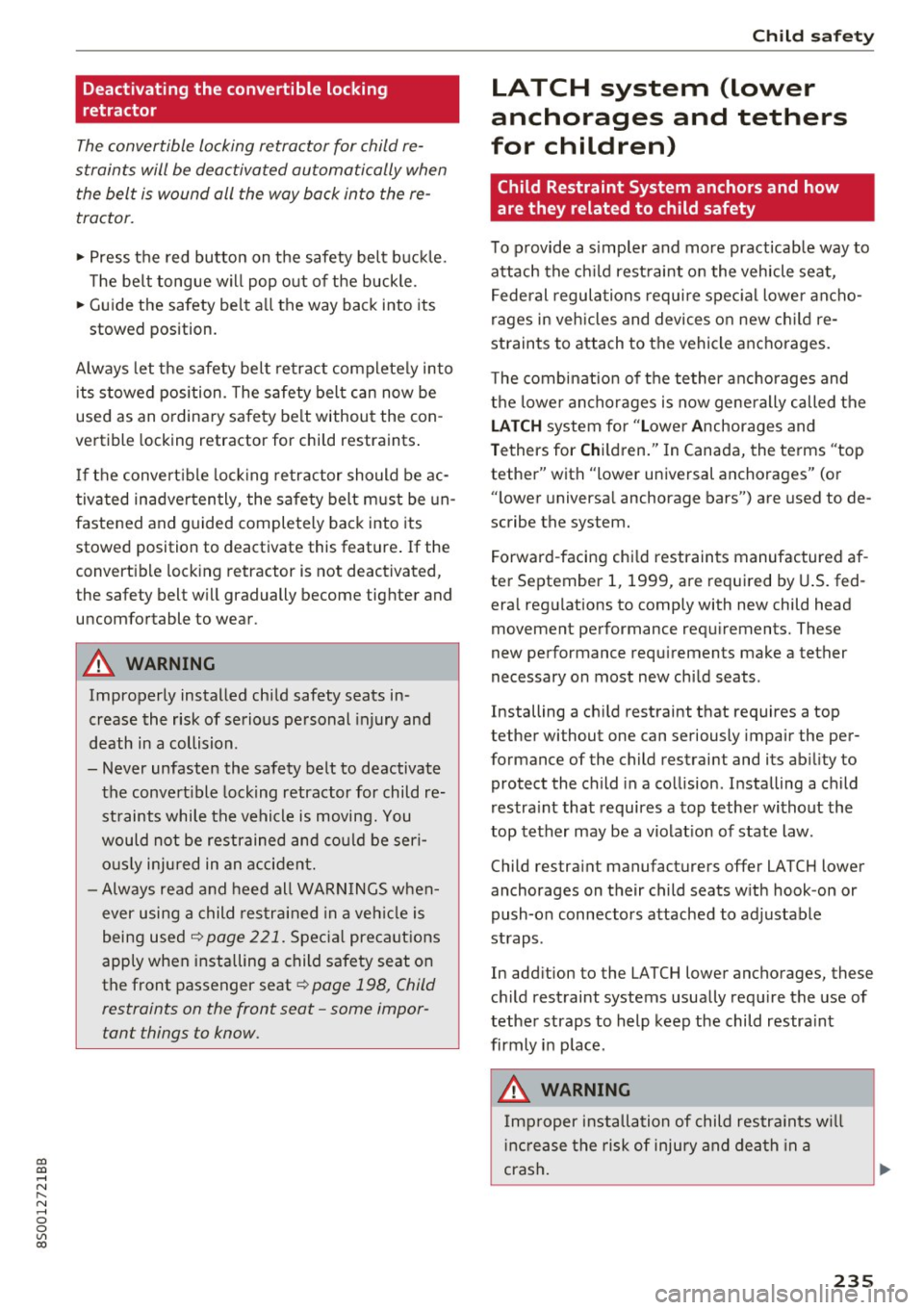
co
co
.... N
" N .... 0
0
Vl c:o
Deactivating the convertible locking
retractor
The convertible locking retractor for child re
s traints will be deactiv ated automatically when
t he belt is wound all the way back into the re
tractor.
" Press the red button on the safety belt buckle.
T he belt tongue will pop o ut of the buckle .
" Guide the safety belt a ll the way back into its
stowed position.
Always let the safety belt retract complete ly into
its stowed position . T he safety belt can now be
used as an o rdinary safety be lt without the con
vertible locking retractor for child restra ints .
If the convert ible lock ing retractor should be ac
tivated inadve rten tly, the safe ty belt must be un
fastened and guided completely back into its
stowed position to deactivate this feature . If the
convertible locking retractor is not deactivated,
the safety belt w ill gradually become tighter and
uncomfortable to wear.
A WARNING
-
Improperly installed child safety seats in
crease the risk of serious personal injury and
death in a collision.
- Never unfasten the safety belt to deactivate
the convert ible locking retractor for child re
st raints while the vehicle is moving. You
would not be restrained and co uld be seri
o usly injured in an accident.
- Always read and heed all WARN INGS when
ever using a child restr ained in a veh icle is
being used
i=;, page 221. Spec ia l precaut ions
apply when installing a child safety seat on
the front passenger seat
¢ page 198, Child
restraints on the front seat -some impor
tant things to know .
Child safety
LATCH system (lower
anchorages and tethers
for children)
Child Restraint System anchors and how
are they related to child safety
To p rovide a s imp ler and more practicab le way to
attach the ch ild rest raint o n the vehicle seat,
Federal regulations require spec ial lower ancho
rages in vehicles and devices on new ch ild re
straints to attach to the vehicle anchorages.
T he combinatio n of t he tether anchorages and
t h e lowe r anchorages is now generally called the
LATCH system for " Lower Anchorages and
T ethers for C hild ren." In Canada, the terms "top
tethe r" with "lower universal anchorages" (or
"lower universa l anchorage bars") are used to de
scribe the system.
Forward-facing chi ld restrain ts manufactured af
ter September
1, 1999, are required by U.S. fed
era l reg ulations to comply with new child head
movement performance requ irements. These
new performance requ irements make a tether
necessary on most new child seats .
Installing a ch ild restraint that requires a top
tether without one can seriously impair the per
formance of the ch ild restraint and its ab ility to
protect the child in a collision . Installing a child
restra int that requires a top tether without the
top tether may be a violat ion of state law.
Child restra int manufacturers offer LATCH lower
anchorages on their child seats w ith hook -on or
push-on connecto rs attached to adjustable
straps .
In add ition to the LATCH lower anchorages, these
child restraint systems usually requ ire the use of
tethe r straps to help keep the child restra int
firmly in p lace .
A WARNING
Imp roper installation of child restra ints w ill
i nc rease the risk of injury and dea th in a
crash.
235
Page 238 of 322
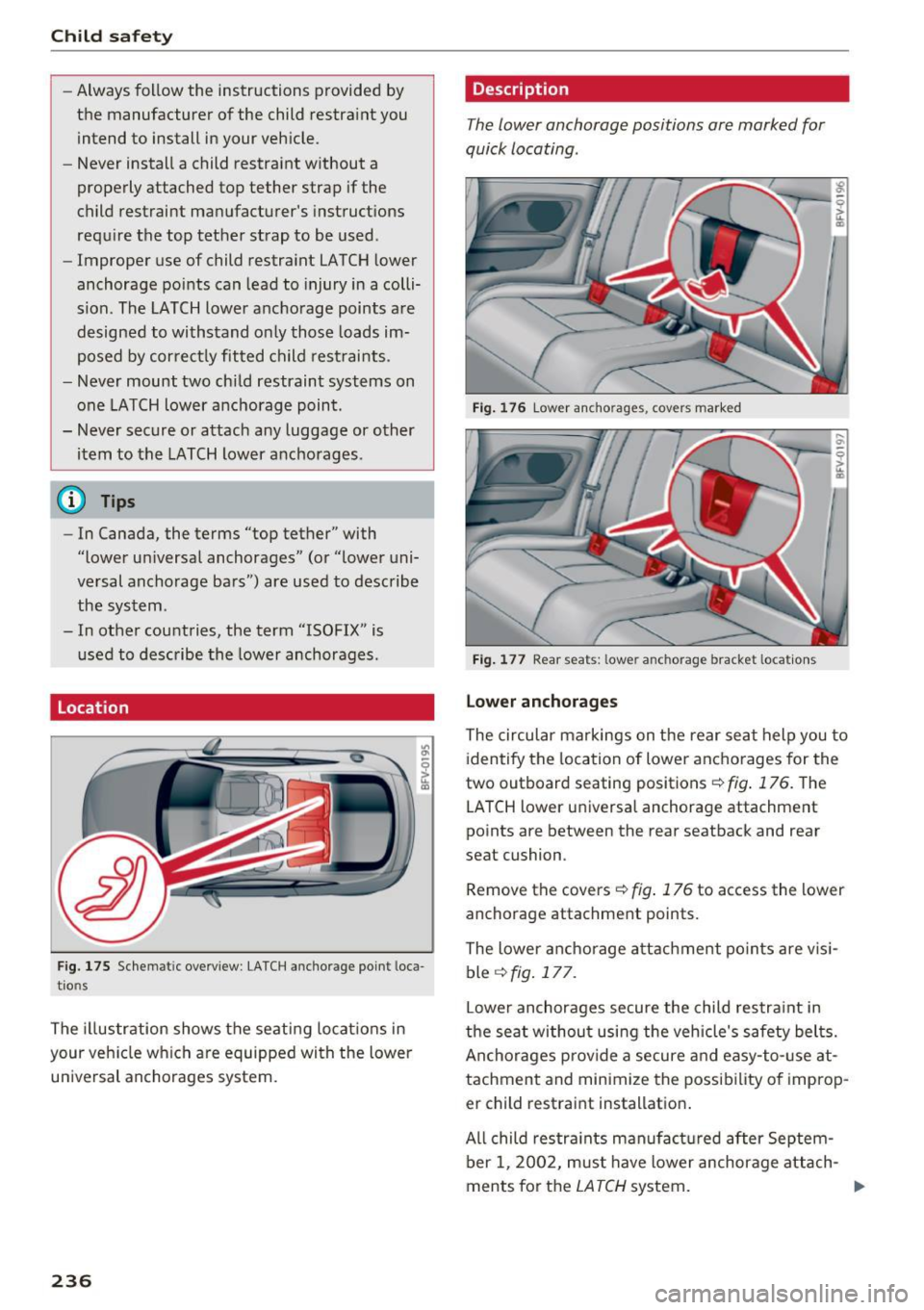
Child safety
-Always follow the instructions provided by
the manufacturer of the child restra int you
intend to install in your vehicle.
- Never install a child restraint without a
properly attached top tether strap if the
child restraint manufacturer's instruct ions
requ ire the top tether strap to be used.
- Improper use of child restraint LATCH lower
anchorage points can lead to injury in a colli
sion. The LATCH lower anchorage points a re
designed to withstand only those loads im
posed by correct ly fitted child rest raints.
- Never mount two ch ild restraint systems on
one LATCH lower a nchorage point.
- Never secure or attach any luggage or other
item to the LATCH lower anchorages .
(D Tips
-In Canada, the terms "top tether" with
"lower u niversal anchorages" (or "lower uni
ve rsal anchorage bars") are used to describe
the system.
- In other countries, the term "ISOFIX" is
u sed to describe the lower anchorages.
Location
F ig. 175 Schemat ic overv iew: LA TCH anc horage point loca
tions
The illustration shows the seating locat io n s in
your veh icle which are equipped with the lower
universal anchorages system.
236
Description
The lower anchorage positions are marked for
quick locating .
Fig. 176 Lower anchorages, covers marked
F ig . 177 Rear seats: lowe r anchorage bracket locations
L o wer anch orag es
The circular markings on t he rear seat help you to
identify the location of lower anc horages for the
two outboard seating positions ¢
fig. 176 . The
LATCH lower universal anchorage attachment
points are between the rear seatback and rear
seat cushion .
Remove the covers ¢
fig. 176 to access the lower
anchorage attachment points.
The lower ancho rage attac hment po ints are v is i
ble ¢
fig. 177.
Lowe r anchorages secure the child restra int in
the seat wi thou t usi ng the vehicle's safety belts.
Anchorages p rov ide a secure and easy-to- use at
tachment and minimize the possibility o f improp
er child restraint installation.
All child restra ints man ufact ured after Septem
ber 1, 2002, must have lower anchorage attach -
ments for the
LATCH system. ..,.
Page 239 of 322
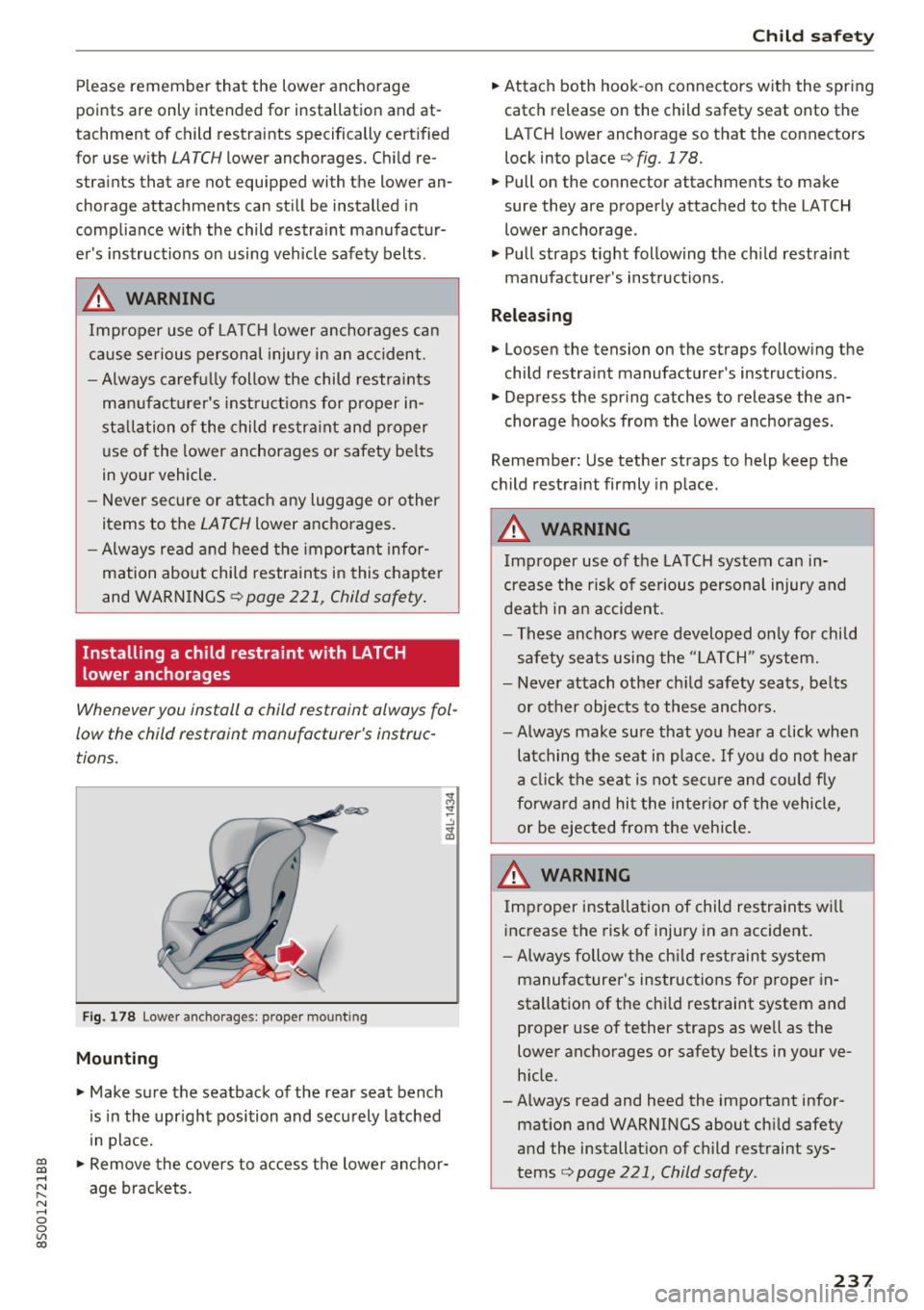
co
co
.... N
" N .... 0
0
Vl c:o
Please remember that the lower anchorage
points are only intended for installation and at
tachment of child restraints specifically cert ified
for use with
LATCH lower anchorages. Child re
straints that are not equipped with the lower an
chorage attachments can still be installed in
compliance w ith the child restra int manufactur
er 's instructions on using vehicle safety belts .
.8, WARNING
Improper use of LATCH lower anchorages can
cause serious personal injury in an accident.
- Always caref ully follow the child restra ints
man ufactu rer's inst ructions for proper in
sta llation of the child restr aint and proper
u se of the lower anchorages or safety be lts
in your vehicle.
- Never secure or attach any luggage or other
items to the
LATCH lower anchorages.
- Always read and heed t he important infor
mation about child restraints in this chapter
and WARNINGS
¢ page 221, Child safety .
Installing a child restraint with LATCH
lower anchorages
Whenever you install a child restraint always fol
low the child restraint manufacturer's instruc
tions.
F ig . 178 Lower anchorages: proper mounting
Mounting
.,. Make sure the seatback of the rear seat bench
is in the upr ight position and sec urely latched
i n place.
.,. Remove the covers to access the lowe r anchor
age brackets.
Ch ild safety
.. Attach both hook-on connectors with the spring
catch release on the child safety seat onto the
LATCH lower anchorage so that the connectors
lock into place ¢
fig. 178 .
.. Pull on the connector attachments to make
sure they are properly attached to the LATCH
lower anchorage .
.. Pull straps tight following the ch ild rest raint
manufacturer 's instructions .
Releas ing
.. Loosen the tension on the straps fo llow ing the
child restra int manufacturer's instructions.
.. Depress the spr ing catches to release the an
chorage hooks from the lower anchorages.
Remember: Use tether straps to help keep the
child restraint firmly in place .
.8, WARNING
--Improper use of the LATCH system can in
crease the risk of se rious persona l injury and
death in an accident .
-
-These anchors were developed only for chi ld
safety sea ts using the "LATCH" system.
- Never attach othe r ch ild safety seats, be lts
or other objects to these anchors.
- Always make sure that you hear a click whe n
latching the seat in place.
If you do not hear
a cl ic k the seat is not se cure and co uld fly
forward and hi t the inter ior of the vehicle,
or be ejected from the vehicle .
.8, WARNING ~ -
I mp roper insta llation of child restra ints w ill
increase the risk of injury in an accident.
- Always fo llow the ch ild restraint system
manufacturer's instructions fo r proper in
stallation of the chi ld restraint system and
proper use of tether straps as well as the
lowe r anchorages or safety belts in yo ur ve
h icle .
-Always read and heed the important infor
mat ion and WARNINGS about ch ild safety
and the installation of child restraint sys
tems¢
page 221, Child safety .
237
Page 240 of 322
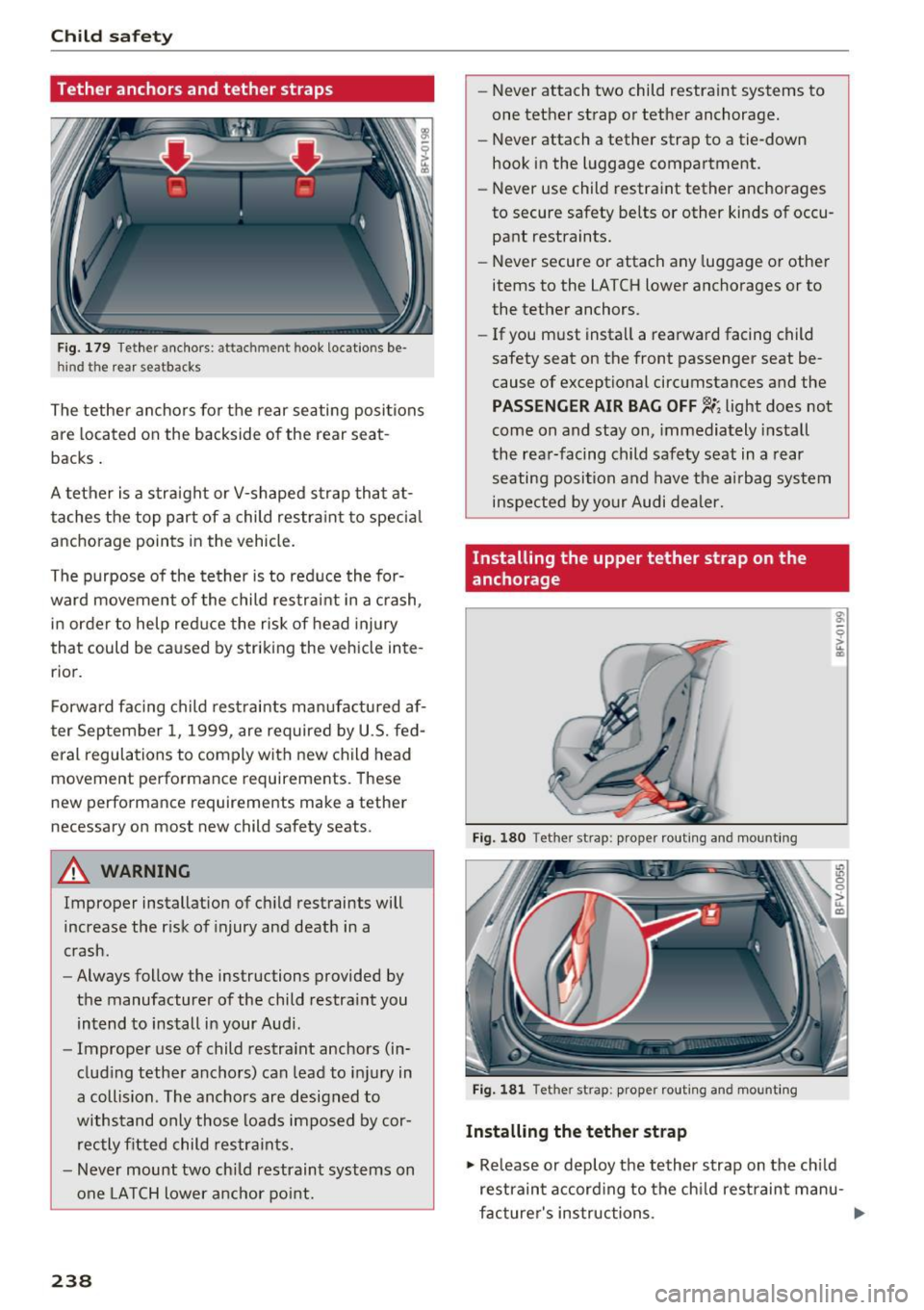
Child safety
Tether anchors and tether straps
Fig. 179 Tether anchors: attachm ent hook locatio ns be
hind the rear seatbacks
The tether anchors fo r the rear seating positions
are located on the backside of the rear seat
backs .
A tether is a stra ight or V-shaped strap tha t at
taches the top part of a child restra int to speci al
anchorage points in the vehicle.
The purpose of the tether is to red uce the for
ward movement of the child restraint in a crash,
in order to help red uce the risk of head injury
that could be caused by strik ing the vehicle inte
rior.
Forward fac ing child restraints manufactured af
ter September 1, 1999, are required by U.S. fed
eral regulations to comply with new child head
movement performance requirements. These
new perfo rmance requirements make a tethe r
necessary on most new child safety seats.
A WARNING
Improper installation of ch ild restraints will
increase the r isk of injury and death in a
crash.
- Always follow the instructions provided by
the manufacturer of the child restra int you
intend to install in your Audi .
- Improper use of child restra int anchors (in
clud ing tether anchors) can lead to inj ury in
a collision . The ancho rs are designed to
withs tand only those loads imposed by cor
rectly fitted child restra ints.
- Never mount two chi ld restraint systems on
one LATCH lower a nchor po int.
238
- Never attach two child restraint systems to
one tether strap or tether anchorage.
- Never attach a tether strap to a tie-down
hook in the luggage compartment .
- Never use child restraint tether anchorages
to secure safety be lts or other kinds of occu
pant restraints.
- Never secure or attach any luggage or othe r
items to the LATCH lower anchorages or to
the tether anchors.
- If you must install a rearward facing child
safety seat on the front passenger seat be
cause of exceptional circumstances and the
PASSEN GER AIR BAG OFF fj,;; light does not
come on and stay on, immediately install
the rea r-facing child safety seat in a rear
seating position and have the ai rbag system
inspected by yo ur Audi dea ler.
Installing the upper tether strap on the
anchorage
F ig. 180 Tether strap: p rope r rout ing and mount ing
F ig. 1 8 1 Tethe r strap: p roper rout ing and mounti ng
Installing the tether strap
.,. Re lease or deploy the tether strap on the ch ild
restraint accord ing to the ch ild restrain t manu
facture r's instructions.